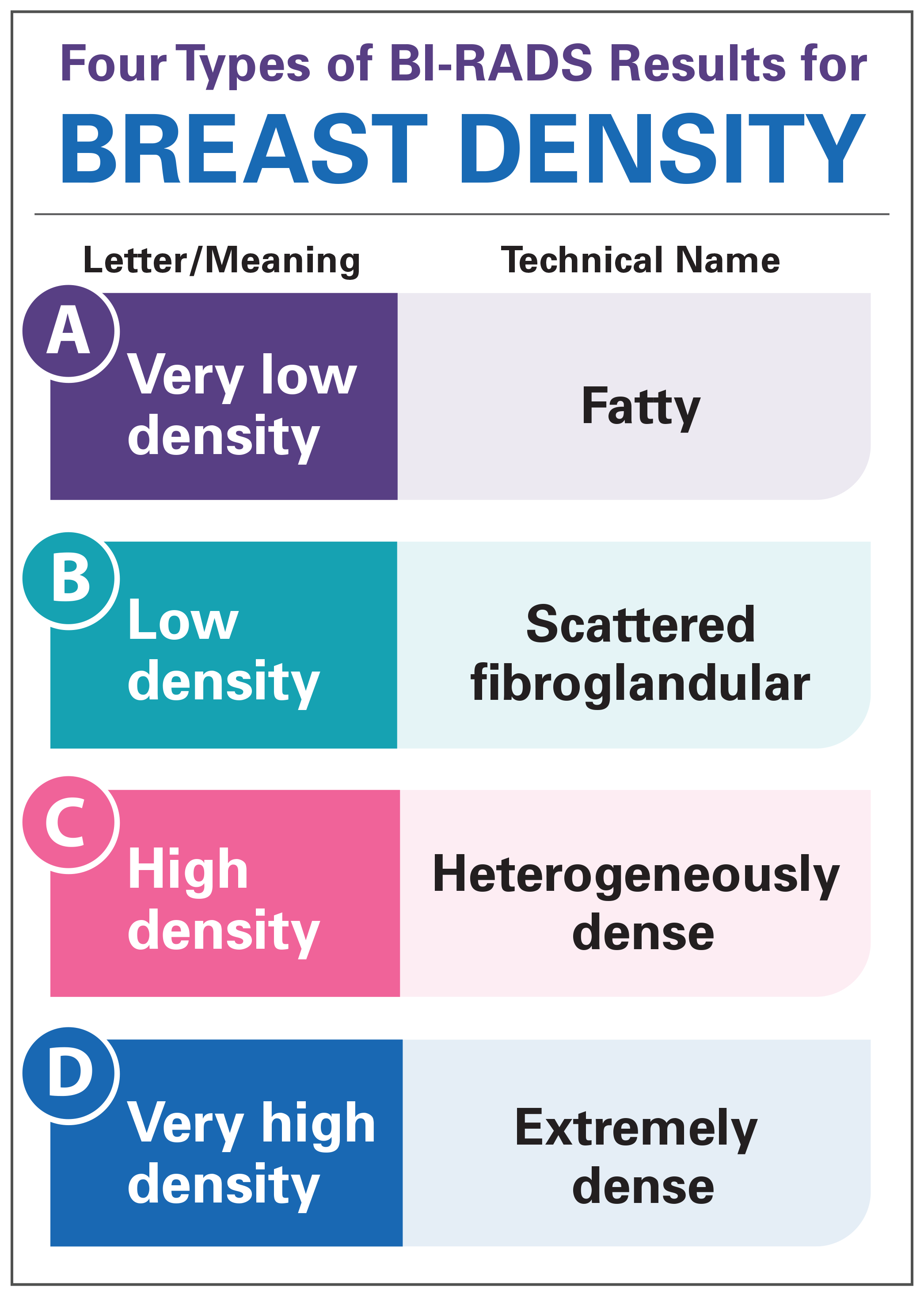Guideline: What is breast density and why does it matter?
New FDA guidelines for mammograms will go into effect by September 2024. Current FDA guidance requires hospitals and breast centers to give people information about their breast density with their mammogram results. By September 2024, mammogram providers will need to relay to patients who have dense breast that they should discuss the need for additional imaging. This article provides an overview of what breast density means and why it matters. (Posted 6/8/23)
Este artículo está disponible en español.

RELEVANCE
Most relevant for: People who have mammograms.
It may also be relevant for:
- previvors
- people with a genetic mutation linked to cancer risk
- people with a family history of cancer
- healthy people with average cancer risk


Relevance: Medium-High
GUIDELINE AT A GLANCE
What is this guideline about?
The now requires that breast density be included in a report.
Why is this guideline important?
Women with dense breasts have a higher chance of getting breast cancer. In addition, dense breast tissue makes it more difficult to find breast cancer on a . It is the perfect storm. Breast density both increases your risk of having breast cancer and makes it harder to find cancer. However, having dense breasts is just one of several risk factors. Knowing about your breast density as well as other risk factors can help you and your doctor decide whether you should have additional screening that may include a breast or .
What's in a report?
reports have two scores.
- A number score between 0 and 6 indicates the finding on your , such as nothing of concern, non-cancer findings or abnormalities.
- A letter score of A to D indicates your breast density. A and B means your breasts are not dense. C and D means you have dense breast tissue.
What is breast density?
Breast density is a rating of how much breast tissue you have. The only way to determine breast density currently is with a . It appears as white areas on your . The denser your breast tissue is the harder it is for doctors to spot cancer on a .
Breasts are made up of different types of tissue. Breasts with lots of fat appear black or dark on . Breasts with lots of breast tissue have more white areas on the . This makes it harder to find cancer because breast cancers also appear as white spots or areas on a . If you have more white breast tissue, it is harder to identify the white breast cancer because of the lack of contrast between the normal breast tissue and the cancer. In addition, people with dense breasts have an increased risk of breast cancer.
How is breast density reported?
Everyone's breasts are different. The amount of dense or fatty tissue varies from person to person.
Doctors use a standard system to report results. The BI-RADS (Breast Imaging and Reporting System) rates breast tissue for the potential presence of cancer and for density. BI-RADS uses letters A through D to separate breast density into four groups:
- A Fatty: The tissue is not dense.
- B Scattered fibroglandular: The tissue is mostly fatty but has some dense areas.
- C Heterogeneously dense: Areas of dense tissue are present. This may make it hard to see small tumors. This occurs in about 40% of people.
- D Extremely dense: It is very difficult to see masses in the breast. This occurs in about 10 percent of people.
People with a BI-RADS score of C or D have dense breasts.

What do BI-RADS number scores mean?
A BI-RADS (Breast Imaging Reporting and Database System) number score is provided on every report to indicate whether findings are normal or abnormal. Not all abnormal findings are cancer.
- Category 0: A score of 0 indicates an incomplete test. The images may have been difficult to read or interpret, and additional screening is required.
- Category 1: The radiologist saw nothing of concern.
- Category 2: Nothing indicates cancer, but non-cancer findings, such as a cyst, were detected.
- Category 3: Changes from your previous that are probably not cancer were identified. Your doctor may recommend additional imaging in 6 months or sooner.
- Category 4: An abnormality that looks like cancer was found and your doctor will recommend a biopsy to determine whether it is benign or cancer.
- Category 5: An abnormality was detected and is likely cancer. Your doctor will recommend a biopsy.
- Category 6: This score is used only for people who have already been diagnosed with breast cancer.
What does the ’s update change?
The 2023 update is a significant change for many hospitals and clinics and one that will benefit people who have . This change is the result of years of advocacy by healthcare professionals and people with dense breasts whose cancers went undetected by . Hospitals and clinics have until September 2024 to make these changes.
The update makes two changes:
- Hospitals and clinics offering are required to provide people with information on the density of their breasts. Some hospitals and clinics already provide this information. If you are screened at a facility that already does, you may not see a change in the information you received in the past.
- To improve accuracy, the will work with hospitals and clinics to make sure that they provide and read correctly.
What does this mean for me?
The breast screening report sent to your provider by the imaging facility will now have a letter grade that indicates your breast density. In women with dense breast tissue, scientific information indicates that additional imaging tests can find cancers that are hidden in dense breast tissue. These imaging studies include and .
Cancer may be found at a later in people with dense breasts because it is harder to spot in a . Cancers that are found later are often harder to treat.
Talk with your doctor or other healthcare provider to learn what type of screening is recommended for you, based on your personal and family medical history. They can tell you about the benefits, risks and costs of additional screening so that you can make a decision that is best for you.
Also, keep in mind that breast density is just one factor that may increase your risk of breast cancer. Your doctor will help you understand the impacts of other risk factors, such as a history of pregnancy and breastfeeding, alcohol use, obesity, family history or having a gene mutation that increases your risk of breast cancer.
If you have a genetic mutation that puts you at higher risk for breast cancer, you may already have additional screenings, including . Doctors can spot cancer that may not be seen on a with or . However, you will still need to get your annual .
Reference
U.S. Food and Drug Administration. Updates Regulations to Require Reporting of Breast Density Information and Enhance Facility Oversight. Published on March 10, 2023.
Disclosure: FORCE receives funding from industry sponsors, including companies that manufacture cancer drugs, tests and devices. All XRAYS articles are written independently of any sponsor and are reviewed by members of our Scientific Advisory Board prior to publication to assure scientific integrity.
Share your thoughts on this XRAY review by taking our brief survey.
posted 6/8/23
Who covered this study?
CNN
FDA to require mammogram reports include breast density information




 This article rates 4.5
out of 5
stars
This article rates 4.5
out of 5
stars
NBC News
FDA sets new guidelines that require mammogram providers to notify about breast density




 This article rates 4.0
out of 5
stars
This article rates 4.0
out of 5
stars
USA Today
FDA is requiring mammogram patients be notified about breast density, a risk factor for cancer




 This article rates 4.0
out of 5
stars
This article rates 4.0
out of 5
stars